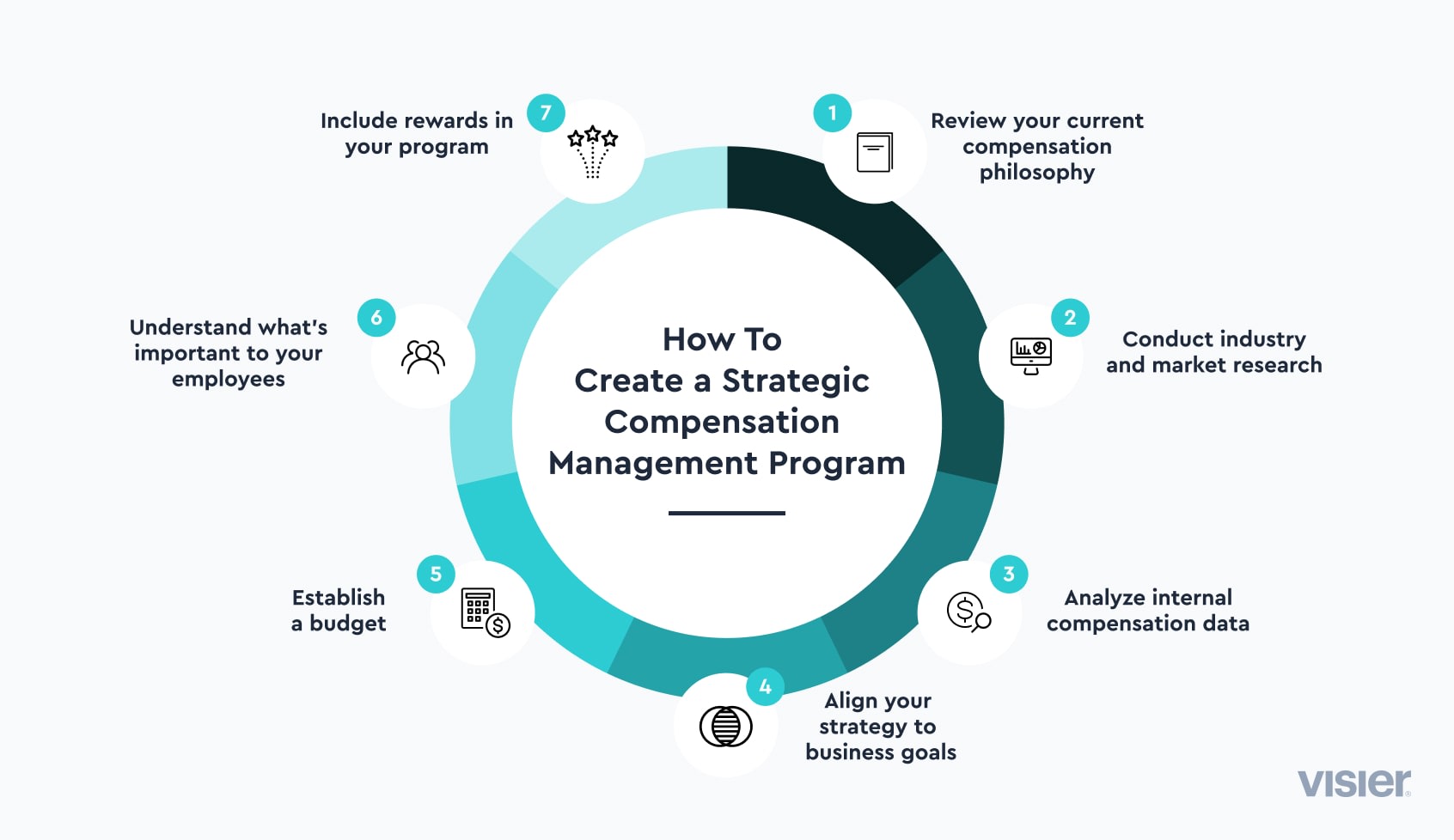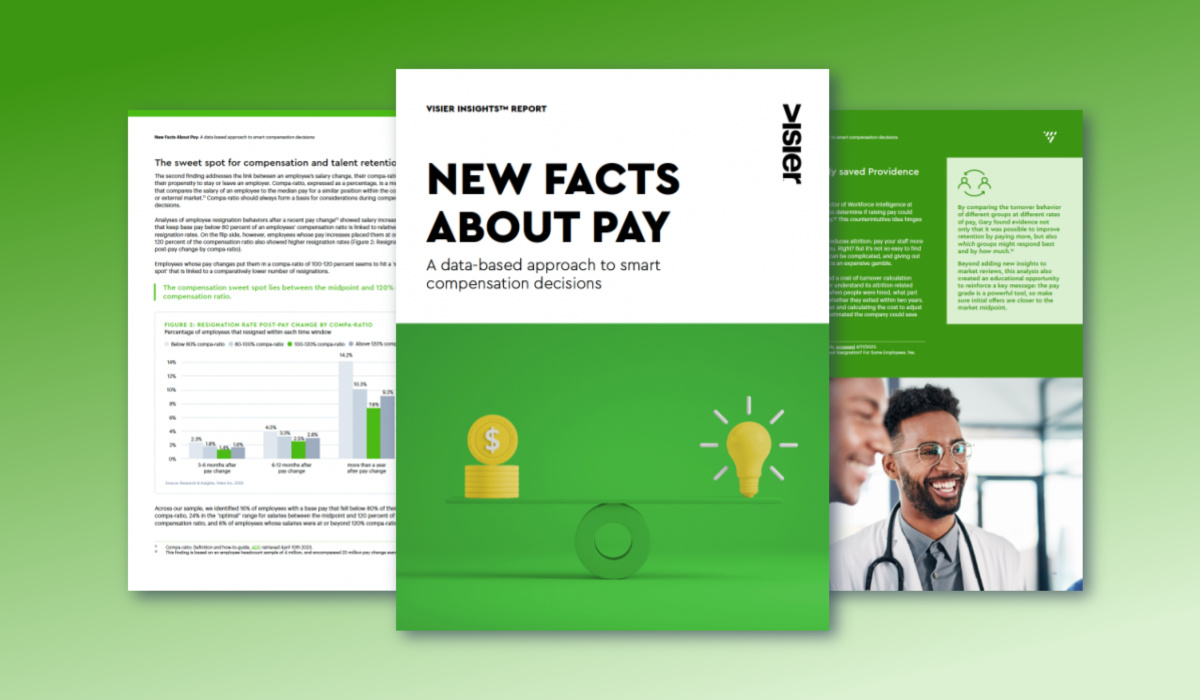COMPENSATION MANAGEMENT
What Is Compensation Management and How Do I Use It To Drive Business Value?
A strong compensation management plan ensures employee satisfaction and pay equity, and the efficient use of company resources. Learn more about how to create a strategic compensation management program.
Get a demo of Smart Compensation
Table of contents
What is compensation management?How to create a strategic compensation management programEffective compensation management programs in actionHow Visier can help you create a compensation management plan that worksWhat is compensation management?
Compensation management refers to the programs, policies, and strategies that companies use to determine employees’ appropriate pay and benefits. It is a key element of employee retention and satisfaction. A successful, complete compensation program uses both financial and non-financial incentives to reward employees.
Compensation management is usually carried out by the HR department. Their responsibilities include ensuring that compensation is competitive by analyzing both internal and external salary figures, economic statistics, and other relevant data.
Types of compensation
There are four main types of compensation:
Hourly pay
Salary
Commission
Bonuses
Hourly pay is great for:
Contract workers
Unskilled workers
Part-time employees
It can also be used to reward full-time employees in case of overtime when they work outside of their normal hours.
Salary is the most common form of compensation. To establish the salary level, take into consideration things like the local minimum wage and the average pay for a certain position.
Bonuses usually accompany the other types of compensation. They’re rewards offered when a person does a stellar job. You can also offer bonuses around the holidays or other special occasions. A bonus can be more than money. A new phone or laptop or even a few extra days off can be a great bonus.
Finally, commission is a type of remuneration you’ll often see in the sales sector. It can be the sole compensation or it can be offered as a bonus to a full-time employee, for instance.

Compensation management is directly tied to employee satisfaction, motivation, retention, and even performance. Prioritizing this aspect of your business will allow you to keep high performers, attract top talent, and stay competitive.
There are several other benefits to creating a compensation management program.
Salaries are often a company’s biggest cost. Without a proper strategy in place, you’re prone to errors. For instance, you could pay too much for a certain position as compared to the rest of the market. That doesn't always mean the best will come to you. You could also allocate bonuses and merit increases left and right without a proper strategy, which will lead to revenue losses.
Pay equity is more important than ever. And a strategic compensation management program helps you ensure you pay everyone a fair wage, without discriminating.
It enables pay transparency, a common request of employees today. When you ensure transparency, you also need to audit salaries and be able to justify merit increases and other bonuses. With a compensation management program in place, you’ll always be prepared to do all that with ease.
Hybrid and remote work can make offering fair wages more difficult. For instance, one might be tempted to reduce the salary of someone moving from a high-wage region to a lower-wage one. But what if those employees travel often? Without compensation management, remuneration in this new era of work can be extremely complicated.

How to create a strategic compensation management program
There are several factors that come into play when creating a compensation management program. These include:
The company’s financial situation
The business goals and overall strategy
The type of work
The market—what other companies pay for similar positions
When working on your compensation management plan, there are a few steps you should follow.
1. Assess your current strategy
To create a new, more effective compensation strategy, you need to look at your current one. Do you notice anything that is inefficient? What’s missing?
Have a general look at it first and then analyze it in-depth. Are you offering bonuses or other merit increases? How are salaries currently established? Did you ever benchmark against the competition?
Use this analysis to set realistic goals and expectations going forward.
2. Conduct market studies
You may have a general idea of how much you want to pay for various positions. But how does it all compare to your competition? How much are others paying? Unless you meet the market, you’ll have a hard time attracting and retaining top performers.
Remember, benchmarking against the competition isn’t a one-time process. You’ll need to repeat it periodically, usually once a year.
3. Establish the budget
Compensation is first and foremost about money, so you need to have a clear budget. How much is going towards compensation?
Discuss the matter with managers and stakeholders and come to a consensus. Don’t forget to factor in things like the local minimum wage and the results of the market studies you conducted.
4. Get employee feedback
Transparency and equity are two key factors in compensation management, so gathering employee feedback will be extremely useful. They won’t decide each other’s salaries. But you can get a better idea of their needs.
For instance, some people may want a compensation package that includes a retirement plan. Others may find it more beneficial to get daycare options for their children.
How should you gather feedback? If you have the time and space, you can choose one-on-one conversations. Otherwise, a company-wide survey can help you get a general idea of what people need.
5. Include rewards
Rewards and bonuses need to be a part of your compensation management program. Don’t leave your employee hanging, thinking you’ll figure it out when the time comes. That’s the best recipe for unfair rewards, lack of transparency, dissatisfaction, and even revenue loss.

Effective compensation management programs in action
Compensation plans will vary from company to company.There’s no one-size-fits-all template. It will all depend on the size of your business, the market, your location, and much more.
Regardless of those factors, there are things you can include in your plan that will boost your strategy and help you achieve your goals. Here are a few practical examples.
1. Annual merit increases for top performers
A merit increase is a fantastic way to reward top performers. It’s also a way to keep all employees motivated, and doing their best.
Determine how often you want to give such an increase. The most common way is correlating it with performance reviews.
However, many companies choose to conduct reviews quarterly. Offering merit increases just as often might get a bit too complicated. Annual increases can be much easier to award.
Be sure to let your employees know what type of performance you expect in order to award the merit increase. Be realistic about your requirements. One should be able to achieve those goals without sacrificing personal time. Make sure that managers are equipped with the tools and knowledge they need to track and report their direct reports’ performance to help them make the case for a merit increase.
Also, think about how much of an increase you want to award. You can choose to award different levels of merit increases. For instance, someone who has exceeded expectations for 2 projects will get 5%. But a person who performed their best in all their projects may get up to 15%.
2. Profit share
Profit sharing is a compensation strategy some companies use when they exceed their annual profit goals. Usually, the profit share is distributed as a percentage of the annual pay. For this reason, many say this compensation tactic benefits those in executive positions more than the rest. But it is still a transparent way to offer a bonus when the company has a good year.
3. Retention bonuses
We spoke a lot about retention strategies and how compensation can help. One example of using compensation to improve retention is using retention bonuses. These are pay increases awarded to employees who’ve been with the company for a certain amount of time.
Another option is rewarding employees who stay with you during a challenging time. Examples include a difficult production period, perhaps when the person needed to do extra hours. On top of the hourly pay, for instance, you can choose to reward the person with an increase.
Retention bonuses show employees that their tenacity is not unnoticed and that you’re grateful they’re part of the company. This improves the experience, increases motivation, and lowers attrition.
4. Choose-your-bonus strategies
While crafting your compensation management program, you asked for employee feedback. One of the key points was what bonuses they’d like.
Their options might be varied. Someone who sees retirement on the horizon might have different thoughts than someone in their 20s.
To make everyone happy, adopting a “choose-your-bonus” strategy could prove beneficial. Don’t worry, that doesn’t mean letting employees ask for anything they can think of.
Look at their feedback first. Then, see what type of rewards you can realistically offer depending on your budget and other factors. Finally, let the employees who earned their bonus choose the one they’d prefer.
This strategy often includes non-financial bonuses such as retirement plans, daycare options, extra PTO, and more.

How Visier can help you create a compensation management plan that works
Compensation management often comes with challenges. Establishing equity, transparency, taking the employees’ feedback into consideration, and incorporating everything so that it fits the budget is no simple task. People analytics—analyzing various HR metrics related to the people in and out of your company—can help you get over those challenges.
If you’re wondering where to get started on that journey, and how to efficiently gather all the right data, Visier People can help you. With it, you can see a clear and unified picture of your people data, check talent insights, and plan the workforce with ease.
Once you have your data insights, it is time to move on to working on that strategic compensation. Doing everything manually can be a time-consuming and error-prone process.
Visier’s Strategic Compensation tool takes some of that load off of your shoulders and makes the process easier. Ensure pay equity, allocate merit increases where they’re due, and calibrate your compensation strategy to the business outcomes that truly matter.
Strategic compensation helps two crucial areas for any business: talent acquisition and retention. Offering a competitive salary and some bonuses is only the first step. Employees are looking for a positive experience, learning and development opportunities, and much more.
Tying it all together: Compensation, hiring, and retention
With Visier’s Talent Acquisition, you can improve recruiter efficiency and create a recruitment process that is easy and effective for both employer and candidate.
Once you have your ideal candidates, you need to move to the next phase—retention. With Visier, you can see when and why a “resignation wave” may have started. Through careful data analysis, you can understand what is motivating your employees and what strategies may help keep them.


